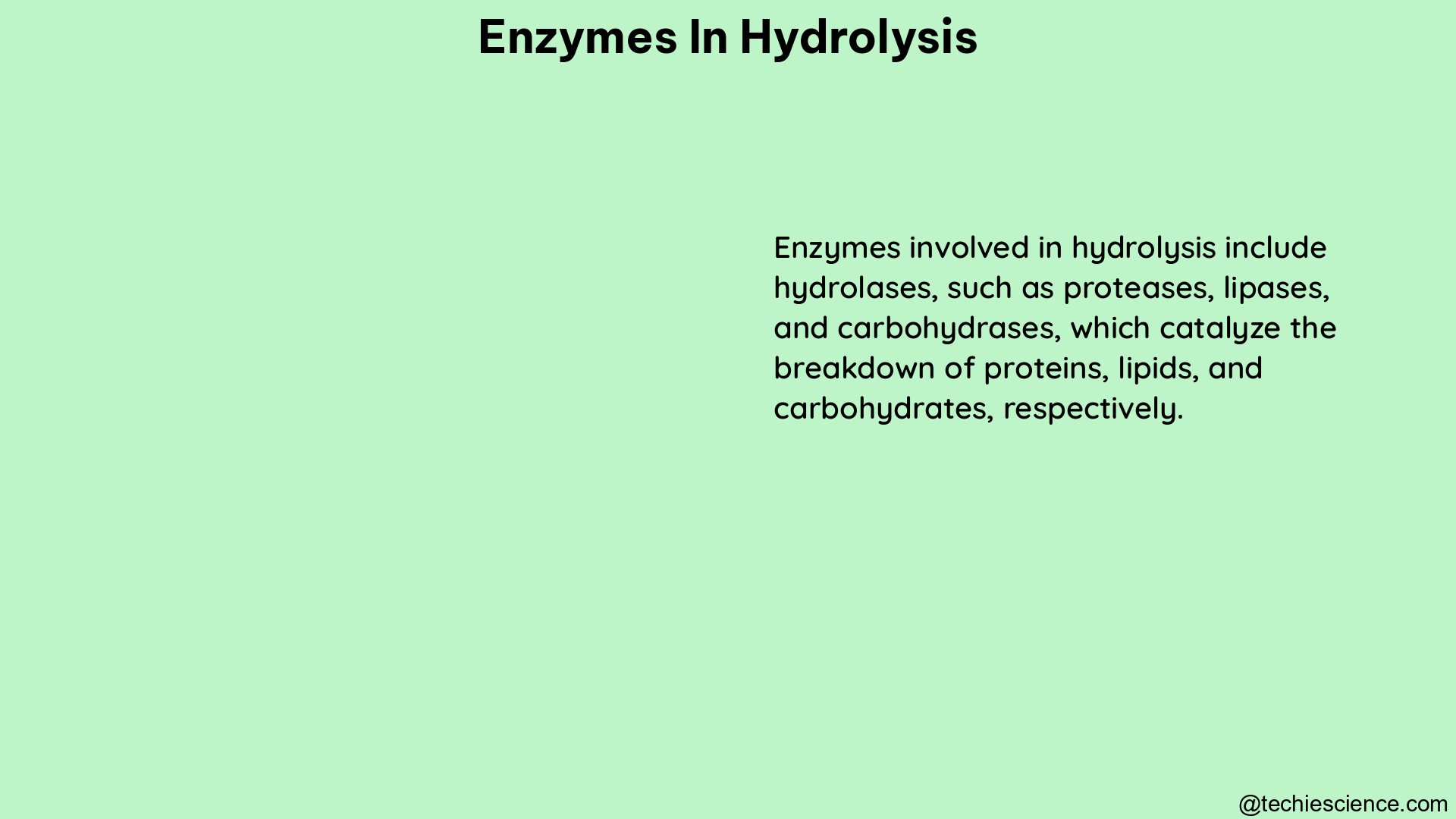Enzymes play a crucial role in the process of hydrolysis, which is the breakdown of larger molecules into smaller ones by the addition of water. This process is fundamental to various biological systems, including digestion, where enzymes break down complex carbohydrates, proteins, and fats into simple sugars, amino acids, and fatty acids, respectively. In this comprehensive guide, we will delve into the intricacies of enzymes in hydrolysis, exploring quantifiable data and advanced biological details.
Degree of Hydrolysis (DH)
The Degree of Hydrolysis (DH) is a quantitative measure of the extent of hydrolysis, defined as the percentage of peptide bonds cleaved by the enzyme. This parameter is calculated using the pH-stat technique developed by Adler-Nissen (1986). The calculation of DH is as follows:
DH = (B × 1/α × 1/MP × 1/htot) × 100
Where:
– B is the base consumption in ml (NaOH)
– Nb is the normality of the base (0.5 N)
– MP is the total mass of protein in the hydrolysate in g
– htot is the total number of peptide bonds in the protein substrate (e.g., 8.8 meq/g protein for whey protein)
– α is the average degree of dissociation of the α-NH2 groups
The DH is a crucial parameter in understanding the extent of protein hydrolysis and can be used to optimize enzyme performance and reaction conditions.
Extraction Efficiency

Extraction efficiency is a measure of the amount of protein extracted from a sample relative to the initial protein content. This parameter is particularly important in the processing of various protein-rich sources, such as plant-based materials. For example, the extraction efficiency of Iranian black cumin was reported to be around 45% with respect to the initial protein content.
Enzyme Adsorption
Enzyme adsorption is the process by which enzymes adhere to a solid surface, such as a substrate. Understanding the quantitative relationship between enzyme adsorption and hydrolysis performance is crucial for optimizing the effectiveness of enzymes, particularly cellulases, against various substrates. While reports on this relationship are relatively rare, it is an important area of study for improving biomass conversion processes.
Enzyme Kinetics
Enzyme kinetics is the study of the rates of enzyme-catalyzed reactions. This involves measuring the initial rate of reaction at different substrate concentrations and calculating the kinetic parameters, such as the Michaelis-Menten constant (Km) and the maximum reaction velocity (Vmax). These parameters provide insights into the efficiency and specificity of the enzyme, which can be used to optimize reaction conditions and enzyme selection.
Inkjet Printing of Proteins
Inkjet printing is a technique used to pattern proteins onto a substrate, allowing for the precise deposition of enzymes and other biomolecules. The amount of protein deposited can be quantified by measuring the volume of ink ejected and the concentration of protein in the ink. This technique has applications in the development of biosensors, tissue engineering, and other areas where the controlled placement of proteins is required.
Real-Time Measurement of Cellobiose and Glucose Formation
The real-time measurement of cellobiose and glucose formation during enzymatic biomass hydrolysis is crucial for understanding the kinetics and efficiency of the hydrolysis process. This can be performed using various analytical techniques, such as high-performance liquid chromatography (HPLC), mass spectrometry, and enzyme-linked immunosorbent assay (ELISA). These methods provide valuable data on the rates of sugar formation, which can be used to optimize enzyme selection, reaction conditions, and process design.
Advanced Techniques for Studying Enzymes in Hydrolysis
In addition to the quantifiable data mentioned above, there are several advanced techniques that can provide deeper insights into the behavior and performance of enzymes in hydrolysis:
-
Nanofiber-based Assays: Ultrasensitive nanofiber-based assays have been developed to study enzymatic hydrolysis and microbial degradation of cellulose, providing detailed information on the kinetics and mechanisms of these processes.
-
Amperometric Enzyme Biosensors: Amperometric enzyme biosensors can be used for real-time measurements of cellobiohydrolase activity on insoluble cellulose, offering a direct and quantitative approach to understanding enzyme-substrate interactions.
-
Benchtop Diffusion NMR Spectroscopy: Quantitative at-line monitoring of enzymatic hydrolysis can be performed using benchtop diffusion nuclear magnetic resonance (NMR) spectroscopy, which allows for the real-time measurement of cellobiose and glucose formation.
-
Quantitative Characterization of Enzyme Adsorption: Advanced techniques, such as quartz crystal microbalance (QCM) and surface plasmon resonance (SPR), have been used to quantitatively characterize the adsorption of cellulases on lignocellulosic substrates, providing insights into the relationship between enzyme adsorption and hydrolytic performance.
These advanced techniques, combined with the quantifiable data discussed earlier, offer a comprehensive understanding of the complex interplay between enzymes and the hydrolysis process, enabling researchers and industry professionals to optimize enzyme performance and improve the efficiency of various biological systems.
Conclusion
Enzymes play a crucial role in the process of hydrolysis, facilitating the breakdown of larger molecules into smaller ones. By understanding the quantifiable data and advanced techniques associated with enzymes in hydrolysis, researchers and industry professionals can gain valuable insights into the efficiency, specificity, and optimization of these essential biological catalysts. This comprehensive guide has provided a detailed overview of the key parameters, measurement methods, and emerging technologies that are shaping the field of enzymes in hydrolysis, equipping readers with the knowledge to tackle complex challenges and drive innovation in various biological applications.
References
- An ultrasensitive nanofiber-based assay for enzymatic hydrolysis and deep-sea microbial degradation of cellulose
- Cellulase activities in biomass conversion: measurement methods and comparison
- An amperometric enzyme biosensor for real‐time measurements of cellobiohydrolase activity on insoluble cellulose
- Real-Time Measurement of Cellobiose and Glucose Formation during Enzymatic Biomass Hydrolysis
- Inkjet printing of proteins
- Inkjet printing – the physics of manipulating liquid jets and drops
- Quantitative characterization of enzyme adsorption and hydrolytic performance of cellulase on lignocellulosic substrates
- Quantitative at‐line monitoring of enzymatic hydrolysis using benchtop diffusion nuclear magnetic resonance (NMR) spectroscopy

Hello, I am Bhairavi Rathod, I have completed my Master’s in Biotechnology and qualified ICAR NET 2021 in Agricultural Biotechnology. My area of specialization is Integrated Biotechnology. I have the experience to teach and write very complex things in a simple way for learners.